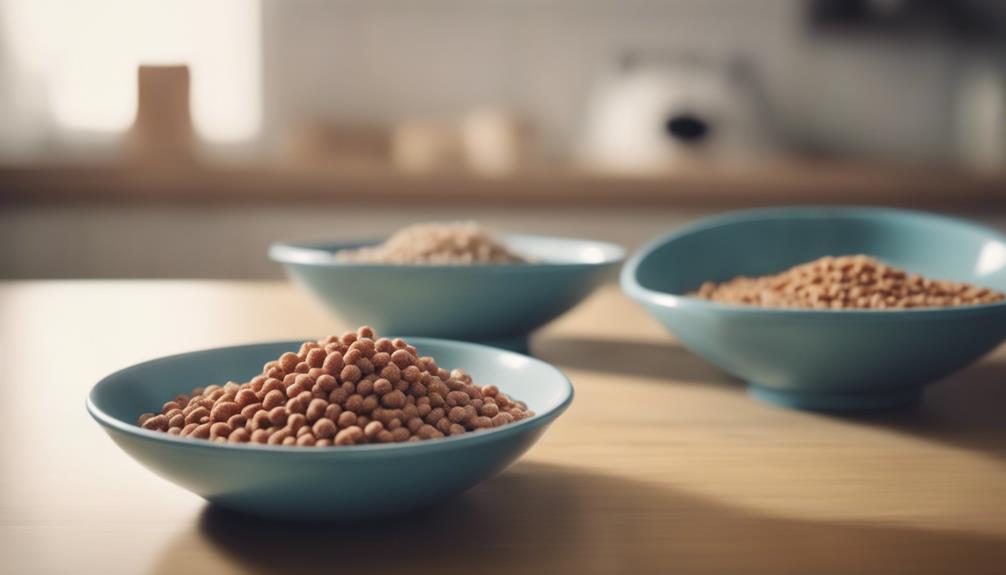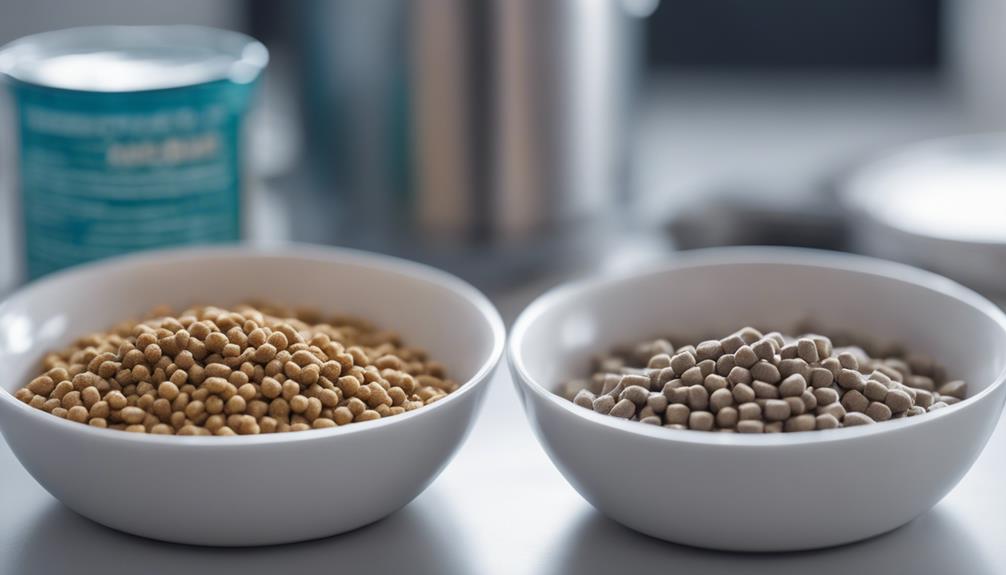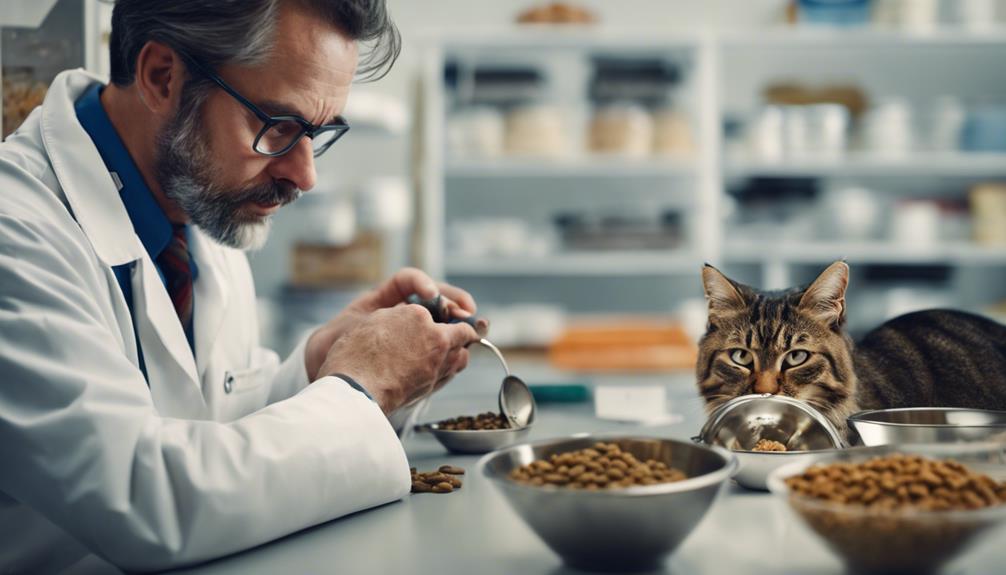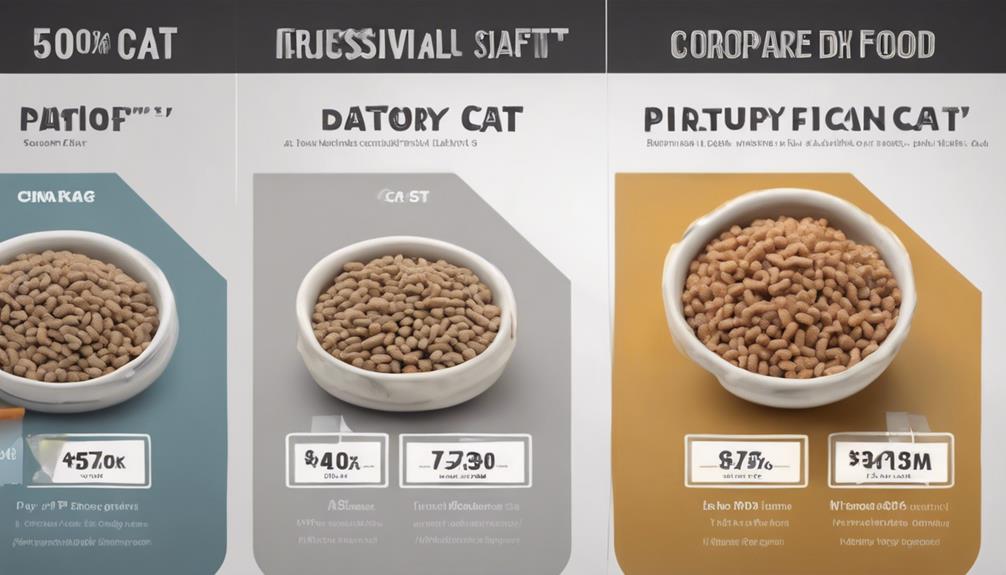As feline caretakers, the choice between wet and dry cat food is a decision that holds significant weight in ensuring the health and well-being of our beloved pets. Feline veterinarians, with their expert insight and knowledge, offer invaluable perspectives on the nutritional nuances between these two dietary options.
Understanding the intricate balance of protein, fat, moisture, and carbohydrates in wet versus dry cat food is just the tip of the iceberg in this extensive comparison. By delving into the complexities of feline nutrition and the impact of food texture preferences, hydration levels, and weight management considerations, a deeper understanding of the optimal dietary choice for our feline friends emerges.
Key Takeaways
- Wet food is higher in moisture, protein, fat, sodium, and phosphorus than dry food.
- Consider cats' texture preferences when choosing between wet and dry food.
- Wet food is low in carbs, beneficial for hydration, while dry food is convenient and energy-dense.
- Transition between wet and dry food gradually to avoid digestive issues and ensure alignment with cat's needs.
Nutritional Variations Between Wet and Dry Food
When comparing the nutritional compositions of wet and dry cat food, it becomes evident that significant differences exist in their water content and levels of essential nutrients.
Wet cat food typically contains 75-78% water, providing hydration benefits to felines. In contrast, dry cat food contains only 6-10% water, making it a more concentrated source of nutrients.
Additionally, wet food tends to have higher levels of protein, fat, sodium, and phosphorus compared to dry food. These variations play a crucial role in meeting the dietary needs of cats, influencing factors such as digestion, hydration, and overall health.
Understanding these nutritional disparities is essential in making informed decisions to cater to the unique requirements of our feline companions.
Pros and Cons Analysis
In evaluating the comparison between wet and dry cat food, it is imperative to weigh the distinct advantages and disadvantages of each option.
Wet cat food, with its high moisture content, aids in hydration and can be beneficial for cats with certain health conditions. It is also low in carbohydrates and calorie density, making it suitable for overweight cats.
On the other hand, dry cat food is convenient for busy families and cats who graze, as it retains freshness for longer periods. Dry food's energy density may be recommended for underweight or senior cats.
However, it is essential to consider cats' unique food preferences and consult a veterinarian to determine the best diet that aligns with both budget and feline health needs.
Feline Food Texture Preferences

Considering the nutritional aspects and pros and cons of wet and dry cat food, understanding feline food texture preferences is paramount in tailoring a diet that aligns with both a cat's health needs and individual tastes.
When it comes to feline food texture preferences:
- Some cats prefer the crunchy texture of dry kibble for dental health benefits.
- Other cats enjoy the moist and meaty texture of wet food for hydration.
- Cats may show a preference for either texture based on their individual likes and dislikes.
- It is essential to observe your cat's reactions to different textures to determine their preferences for optimal meal enjoyment and health benefits.
Hydration and Health Benefits
Adequate hydration plays a crucial role in promoting optimal health benefits for cats. Wet cat food, with its high moisture content of 75-78%, helps keep cats hydrated, supporting kidney function and preventing urinary issues.
This increased water intake aids in digestion and can benefit cats with certain health conditions like kidney disease or diabetes. Proper hydration also contributes to healthy skin and coat, overall well-being, and may reduce the risk of obesity.
Additionally, wet food can be particularly beneficial for cats who are reluctant drinkers or prone to dehydration. By incorporating wet food into a cat's diet, owners can help ensure their feline companions stay hydrated and enjoy the associated health advantages.
Weight Management Considerations

Hydration is a key component of a cat's overall health, particularly in managing weight effectively. When considering weight management for your feline companion, there are several crucial factors to keep in mind:
- Caloric Content: Monitoring the calorie intake of your cat is essential for weight management.
- Meal Frequency: Establishing a consistent feeding schedule can help regulate your cat's metabolism.
- Exercise Routine: Encouraging physical activity through playtime and interactive toys can aid in weight control.
- Consulting a Veterinarian: Seeking professional advice from a veterinarian can provide tailored weight management strategies for your cat's specific needs.
Dental Care and Dry Food
Maintaining proper dental hygiene in cats is essential for their overall health and well-being, with dry cat food playing a role in dental care efforts.
While some dry cat foods are formulated to assist in cleaning teeth, it is crucial to note that brushing remains essential for optimal dental health. Dental disease can significantly impact a cat's quality of life and even decrease their life expectancy.
Regular veterinary check-ups and professional dental cleanings are also vital components of maintaining good oral health in cats.
Cost-Effective Feeding Options

Exploring cost-effective feeding options for cats involves considering both the financial implications and the nutritional value of different cat food choices. When balancing cost and quality, it's essential to keep your feline friend's health at the forefront. Here are some tips for cost-effective feeding options:
- Compare prices per ounce of wet and dry cat food to make an informed decision.
- Look for bulk purchasing or subscription options to save money in the long run.
- Consider store brands or generic alternatives that still meet your cat's nutritional needs.
- Consult with your veterinarian to find affordable yet high-quality cat food options tailored to your cat's specific requirements.
Transitioning Between Food Types
To smoothly shift your cat's diet between wet and dry food varieties, a gradual transition over a 5-7 day period is advisable. Start by mixing increasing amounts of the new food with decreasing amounts of the old food daily. This gradual change helps prevent gastrointestinal upset and allows your cat to adjust to the new diet comfortably.
Keep an eye on your cat's response during this transition period. If your cat refuses to switch to the new diet or shows any signs of digestive issues, consult with a veterinarian. Remember to consider your cat's health needs and preferences when selecting the new food to ensure a smooth and successful transition process.
Cat Food Budgeting Tips

When considering your cat's dietary needs, it's essential to factor in budgeting considerations to ensure their health and well-being are maintained without overspending. Here are some cat food budgeting tips to help you make informed decisions:
- Compare Prices: Look for sales and discounts on cat food brands.
- Buy in Bulk: Purchasing larger quantities can often lead to cost savings.
- Consider Store Brands: Some store brands offer quality nutrition at a lower price point.
- Use Coupons and Rewards: Take advantage of coupons and loyalty programs to save on cat food purchases.
Veterinary Guidance for Diet Selection
Optimal diet selection for cats often necessitates expert guidance from veterinarians to ensure their nutritional requirements are met effectively. Veterinarians play a crucial role in assessing a cat's specific health needs, such as weight management, dental health, and any underlying medical conditions.
They can provide tailored recommendations on whether wet or dry food is more suitable based on the individual cat's preferences and requirements. Additionally, veterinarians can offer guidance on transitioning between different types of food to prevent digestive issues and ensure a smooth adjustment period.
Seeking veterinary advice for diet selection can help cat owners make informed choices that promote their feline companion's overall health and well-being.
Conclusion
In the realm of feline nutrition, the debate between wet and dry cat food mirrors a delicate dance between two contrasting paths. Just as a cat gracefully navigates its surroundings with precision and care, pet owners must delicately balance the nutritional needs and preferences of their feline companions.
By choosing the right dietary path, pet owners can ensure their cat's health and well-being flourish like a vibrant garden under the nurturing rays of the sun.




